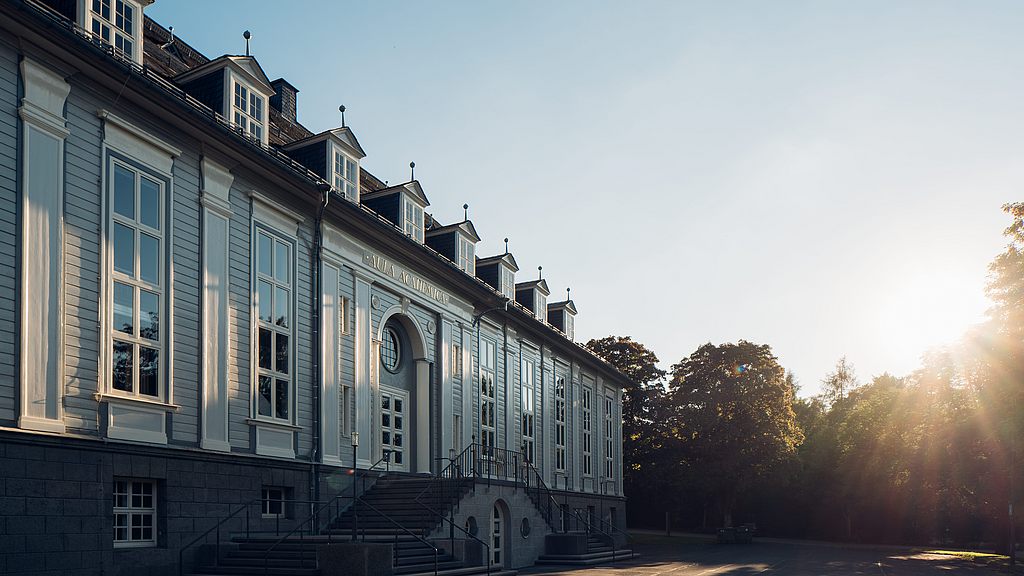History and Development of Clausthal University of Technology
The rich ore deposits in the Harz Mountains were the breeding ground for the economic importance of the region as a center of raw materials production. They formed the roots of the “Clausthaler montanistische Lehrstätte” founded in 1775 from which the internationally renowned “Bergakademie” (Mining Academy of Clausthal) originated in 1864.
Since its foundation, the University has been associated with landmarks of technical progress: sophisticated systems for the use of water power to operate mining and processing machines, the wire cable as well as precise mining surveillance instruments were invented in Clausthal. Famous scientists such as Gottfried Wilhelm Leibniz, Arnold Sommerfeld or Friedrich Wilhelm Heinrich von Trebra, a friend of Goethe, are connected with the history of Clausthal.
For a long time, education and scientific research were focused on mining and metallurgy, as well as on earth sciences. However, during the 1960s the range of studies was significantly expanded. Major courses of study from Chemistry and Physics to Mathematics and Materials Science all the way to Mechanical Engineering and Process Engineering resulted in structural changes which led to renaming the institution “Clausthal University of Technology” in 1968.
Bridging the gap between tradition and innovation, further pioneering courses of study followed: in the past twenty years, courses were introduced in Informatics, Chemical Engineering and Environmental Technology, Power Systems Engineering, Physics/Physical Technology, and Plastics Engineering, these were followed by courses in Business Sciences such as Industrial Engineering, Business Mathematics and Business Informatics. As a result of this reorientation, the number of students has increased sharply.
The new direction in teaching led to enhanced research activities: in 1986 the interdisciplinary “Forschungsverbund Umwelttechnik (Association for Environmental Engineering Research) was founded from which the CUTEC Institute originated. The CUTEC Institute is a stately research institute with excellent ties to industry. The Arnold Sommerfeld Institute combines Physics and Mathematics to study complex physical systems. Chemists, physicists and engineers work closely together on the production and use of new materials in the Polymer Research Center. With the Center of Simulation Technology (Simulationswissenschaftliches Zentrum) an interdisciplinary scientific institution was created for the study of information technology in science, economy and society. An energy research center, the Energie-Forschungszentrum Niedersachen (EFZN), in Goslar has emerged from Clausthal University of Technology.
Clausthal University of Technology is active in a number of special research fields such as the development of new materials and forms of energy, the improvement of engineering processes by new equipment, as well as in the field of oil and natural gas research or the exploration of textures. For this work, scientists from Clausthal University of Technology have received numerous technology awards. CUT participated in space projects and is also well known for its start-up companies which are offshoots of the University.
Despite all its innovative developments, the core area of teaching and research at Clausthal University of Technology is deeply rooted in the exploitation, refining, storage, distribution, use and reuse of the resources of our earth – be it materials, energy or information. This gives the direction for research in Chemistry, Physics or Earth Sciences, as well as for the Engineering Sciences such as Mechanical Engineering, Process Engineering, Mining/Geotechnical Engineering and Materials Science or Mathematics, Informatics and Economics. The compact size of the University and the fact that facilities and institutes lie within a short distance encourage interfaculty cooperation which is but one reason for the superb worldwide reputation of Clausthal University of Technology.
About 90 professors and over 400 members of research staff as well as 500 technical and administrative employees of about 45 facilities are responsible for teaching and research. Up to one third of the total budget is raised through research. Therefore the non-professorial teaching staff is particularly well developed. Honorary professors and visiting lecturers from industry strengthen our programs of teaching with practice-oriented offers. Overall, the University has more than 1,100 employees, including 100 apprentices.
Important events
1775 Founded as the "Clausthal Mining School"
1810 Two-track mining school for the training of miners and civil servants
1864 "Bergakademie Clausthal", international importance as one of the leading educational institutions in mining and metallurgy
1968 "Clausthal University of Technology", significant expansion of the teaching and research spectrum (mechanical engineering, process engineering, mathematics, physics, chemistry)
1984 and 1991 Successful spin-offs from the university: Sympatec GmbH is now the world market leader in particle measurement technology, the SincoTec Group is the world market leader in resonance testing technology
2000 Expansion of the economic sciences
2007 Foundation stone laid for the Energy Research Centre in Goslar; Clausthal research centers for materials, simulation, drilling technology (in Celle) and digitalization follow
2015 All-time high with 4963 students
2017 Takeover of the Clausthal Institute of Environmental Technology (CUTEC) by the university
2018 TU Clausthal wins the German Sustainability Award
2020 University of the Circular Economy
